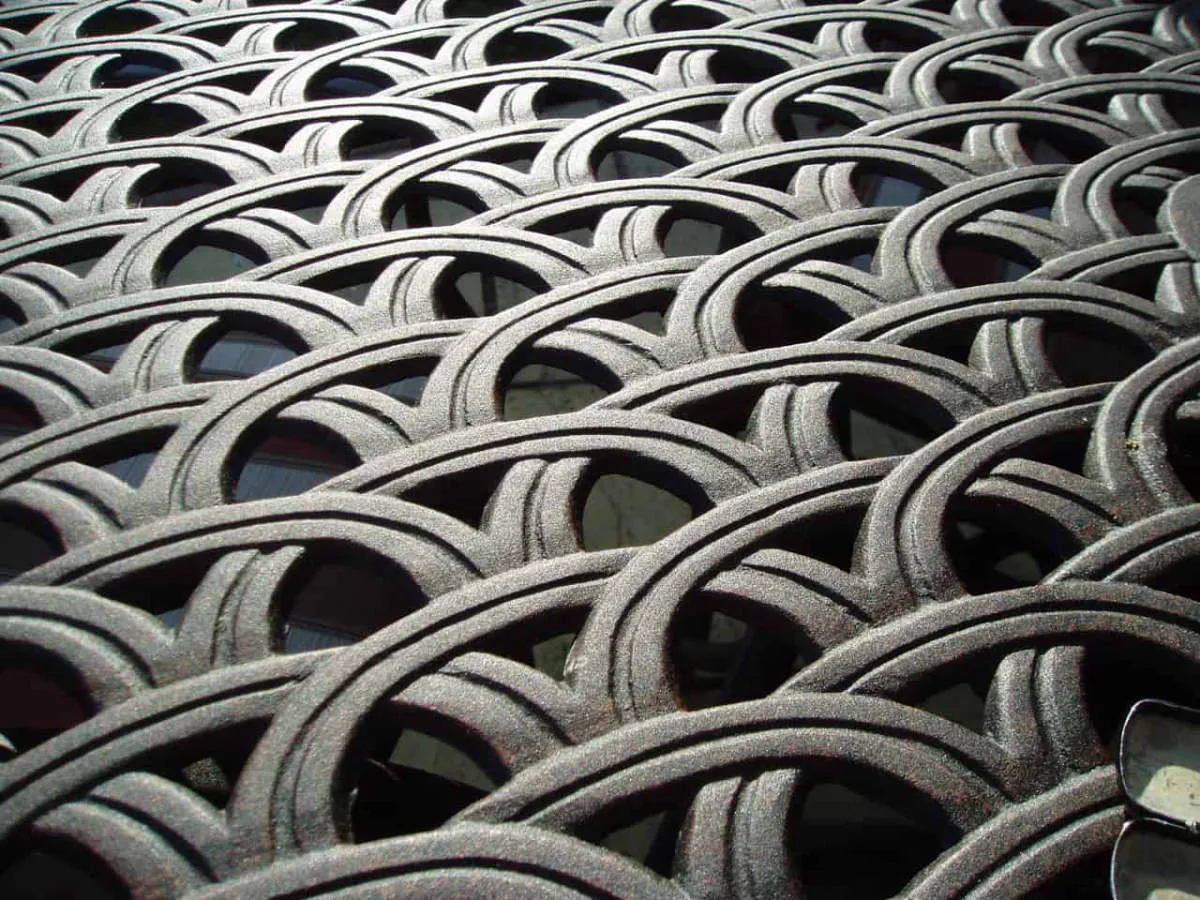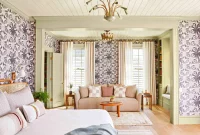Discover the transformative power of coordinating wallpaper patterns in creating stunning interiors. From subtle accent walls to bold statement pieces, learn how to master the art of wallpaper coordination to elevate your home décor. Unlock the potential of patterns and create a harmonious and visually captivating space.
Mixing and Matching Wallpaper Designs

When it comes to interior design, wallpaper can play a powerful role in transforming a space. Gone are the days where using a single wallpaper design throughout a room was the norm. The latest trend in wallpaper coordination is all about mixing and matching different patterns to create a unique and visually stunning look.
The Art of Coordination
Mastering the art of wallpaper coordination involves finding the right combination of patterns that work harmoniously together. It requires attention to detail and a good understanding of color theory. By carefully selecting wallpapers with complementary color schemes or patterns that share a common theme, you can create a cohesive and eye-catching design scheme.
Balance is Key
One of the essential elements of successful wallpaper coordination is achieving balance. Balancing bold, vibrant patterns with more subtle or neutral designs can help prevent the room from becoming overwhelming. Experiment with different scales of patterns to add depth and visual interest to the space.
Creating Focal Points
Another effective way to mix and match wallpaper designs is by creating focal points within the room. Choose a wall or an area that you want to highlight and select a standout wallpaper pattern for that specific space. This can be particularly effective in living rooms, dining areas, or bedrooms.
Accentuating Architectural Features
Wallpaper coordination can also be used to accentuate the existing architectural features of a room. By applying different patterns to various parts of the walls, such as alcoves or recessed areas, you can draw attention to these elements and enhance their visual impact.
Experimenting with Styles
Don’t be afraid to mix different wallpaper styles, such as combining a traditional floral design with a contemporary geometric pattern. This juxtaposition of styles can create a dynamic and visually stimulating environment. However, be sure to keep in mind the overall aesthetic of the room and ensure that the combination feels intentional.
Conclusion
Mastering the art of mixing and matching wallpaper designs allows you to unleash your creativity and infuse your living spaces with personality and charm. By understanding the principles of coordination, balance, focal points, and accentuation, you can create stunning interiors that are truly unique to your style.
Wallpaper as a Room’s Focal Point
Wallpaper is more than just a decorative element on the wall; it has the power to transform a room into a stunning visual spectacle. When used correctly, wallpaper can become the focal point of any space, adding depth, personality, and style.
One of the key aspects of mastering the art of wallpaper coordination is selecting the right pattern. The pattern should complement the overall theme and color scheme of the room. It can be a bold and vibrant print for a statement wall or a subtle design that adds texture and visual interest.
Another important consideration is the scale of the pattern. Large-scale patterns can make a room feel cozy and intimate, while smaller patterns can create a sense of spaciousness. Mixing patterns is also an option, but it requires careful planning to ensure they harmonize with each other rather than clash.
In addition to pattern, the placement of wallpaper can greatly impact the room’s aesthetic. Consider using wallpaper on an accent wall to draw attention to a specific area, such as behind a bed or a fireplace. Alternatively, applying it to the ceiling can add a unique touch and make the room feel more expansive.
It’s essential to remember that wallpaper coordination isn’t limited to walls only. Using the same or complementary wallpaper on furniture, such as cabinets or shelves, can create a cohesive and visually striking look.
Lastly, don’t overlook the importance of lighting. Proper lighting can enhance the beauty of wallpaper and bring out its intricate details or textures. Experiment with different light sources, such as wall sconces or pendant lights, to create different moods and highlight specific areas.
When done right, wallpaper can transform a room from ordinary to extraordinary. By considering the pattern, scale, placement, and lighting, you can unlock the full potential of wallpaper, turning it into the focal point that elevates your space into a work of art.
Eco-Friendly Wallpaper Selections
When it comes to home decoration, wallpaper is a versatile and popular choice. However, it’s essential to consider the environmental impact of the wallpaper we choose. By opting for eco-friendly wallpaper, you can create a stylish and sustainable space. Here are some fantastic eco-friendly wallpaper selections to enhance your home:
1. Recycled Wallpaper
Recycled wallpaper is an excellent choice for those looking to reduce waste and promote sustainability. Made from post-consumer materials, such as recycled paper or fabric, these wallpapers not only add a unique touch to your walls but also help minimize environmental footprint.
2. Natural Fiber Wallpaper
Wallpapers made from natural fibers, such as grasscloth, bamboo, or hemp, are both eco-friendly and visually appealing. These materials are renewable, biodegradable, and often produced using low-impact methods, making them an excellent choice for environmentally conscious homeowners.
3. Water-based Ink Wallpaper
Traditional wallpaper often contains heavy chemicals and solvents in their ink. Opting for water-based ink wallpaper eliminates these harmful substances. These wallpapers are manufactured using water instead of toxic chemicals, reducing the impact on both indoor air quality and the environment.
4. VOC-Free Wallpaper
Volatile Organic Compounds (VOCs) are chemicals that can be emitted from various household products, including wallpaper. Choosing VOC-free wallpaper ensures that your walls remain free from these harmful pollutants, contributing to a healthier and more eco-friendly living environment.
5. Non-Toxic Adhesive
Lastly, don’t forget to pair your eco-friendly wallpaper with a non-toxic adhesive. Look for adhesives that are formaldehyde-free and low in VOCs. This ensures that the entire wallpaper installation process remains environmentally friendly.
By selecting eco-friendly wallpaper options and accessories, you can create a beautiful living space while also minimizing the environmental impact. Consider these sustainable choices for your next home decoration project, and enjoy the benefits of eco-conscious interior design.
Wallpaper Tips for Small Spaces
In small spaces, using wallpapers can be a powerful tool in both enhancing the visual appeal and creating the illusion of a larger area. With the right coordination and selection of patterns, you can transform your small space into a stylish haven. Here are some tips to help you master the art of wallpaper coordination:
1. Opt for Light and Soft Colors
When working with a small space, it’s best to choose wallpapers in light and soft colors. These shades will reflect light and make the room feel more spacious. Avoid dark and bold patterns as they can make the space feel cramped and overwhelming.
2. Stick to Subtle Patterns
Incorporating subtle patterns can add depth and texture to your small space without overwhelming it. Opt for delicate floral designs, geometric shapes, or simple stripes. These patterns can create visual interest while maintaining a sense of openness.
3. Consider Vertical Patterns
To create the illusion of height in your small space, consider using wallpapers with vertical patterns. Vertical stripes or motifs can draw the eye upwards, making the room appear taller and more expansive.
4. Coordinate with Solid Colors
Pairing your wallpaper with solid-colored elements can help balance the overall look. Consider coordinating your furniture or accessories with the dominant colors in the wallpaper to create a cohesive and harmonious atmosphere.
5. Accentuate a Single Wall
If you have a limited amount of wallpaper or want to avoid overwhelming the space, focus on accentuating a single wall. Choose a wall that serves as a focal point, such as the one behind a bed or a sofa. By doing so, you can create a stunning visual impact without overpowering the entire room.
6. Create a Seamless Transition
To create a sense of continuity, choose a wallpaper design that complements the overall style and color palette of your small space. This will help create a seamless transition between walls, giving the impression of a more expansive area.
By implementing these wallpaper tips, you can maximize the visual potential of your small space. Remember to explore different styles, experiment with patterns, and most importantly, have fun designing your ultimate wallpaper coordination!
Balancing Color and Pattern
In the world of interior design, the coordination of colors and patterns can make or break the overall aesthetic appeal of a space. One element that plays a significant role in adding visual interest and personality to a room is wallpaper. Wallpaper provides an opportunity to experiment with different patterns, colors, and textures, allowing homeowners to create a unique and harmonious environment.
The Importance of Color
When it comes to balancing color and pattern, it’s crucial to consider the color palette of your wallpaper. The colors you choose should complement or contrast harmoniously with the overall color scheme of the room. If your room features neutral tones, opting for a bold and vibrant wallpaper with complementary colors can create a stunning focal point. On the other hand, if your room already has plenty of color, a more subtle and monochromatic wallpaper can provide a sense of balance.
Playing with Patterns
Coordinating patterns can be a bit challenging but immensely rewarding when done right. To strike a balance, it’s essential to vary the scale and complexity of the patterns used. If your wallpaper has a large-scale pattern, consider incorporating smaller patterns in your furniture upholstery or accessories. Alternatively, if your wallpaper features a busy and intricate pattern, opt for simpler patterns or solid colors in other elements of the room.
Creating Harmony
Remember, achieving balance is about finding harmony between colors and patterns. One way to do this is by selecting wallpaper that includes multiple colors within the pattern. This allows you to pull different shades from the wallpaper and use them as inspiration for coordinating furniture, rugs, curtains, and other decorative elements. By bringing elements of the wallpaper into the rest of the room, you can create a cohesive and harmonious space.
Maintaining Simplicity
Although coordination is essential, it’s crucial not to go overboard. Avoid using too many competing patterns or colors, as this can result in visual chaos. Instead, focus on selecting a few key patterns and colors that work well together, allowing them to take center stage. Remember, simplicity can often have a more significant impact.
Final Thoughts
Balancing color and pattern in wallpaper coordination requires a keen eye for design and a willingness to experiment. By carefully selecting colors, playing with patterns, creating harmony, and maintaining simplicity, you can achieve a visually stunning and harmonious space that truly reflects your personal style.
Creative Wallpaper Placement Ideas
When it comes to interior design, wallpaper can be a powerful tool to transform a space, adding color, pattern, and personality. To truly master the art of wallpaper coordination, it is essential to think beyond just covering the walls. Here are some creative ideas for placing wallpaper that will take your décor to the next level:
1. Accent Wall
Instead of wallpapering an entire room, choose one wall as a focal point. This can be the wall behind the headboard in a bedroom, the chimney breast in a living room, or the dining area in a kitchen. By creating an accent wall, you can highlight architectural features or create a striking backdrop for furniture and artwork.
2. Ceiling Treatment
For a truly unique and unexpected look, consider wallpapering the ceiling. This adds an element of surprise and can draw the eye upward, making the space feel larger. Opt for patterns with a light background or use metallic accents to reflect light and create a stunning visual impact.
3. Furniture Makeover
Unleash your creativity by using wallpaper to transform your furniture. Apply it to the backs of bookshelves, the fronts of drawers, or even the sides of cabinets to add a pop of pattern and breathe new life into old pieces. This not only creates a statement but also allows you to personalize and customize your furniture.
4. Statement Staircase
Elevate your staircase design by wallpapering the risers. Whether you go for bold and vibrant patterns or subtle and understated designs, this unexpected touch will add character and visual interest to your home. It’s a small yet impactful way of making your staircase a statement piece.
5. Door Accents
Don’t forget about your doors! Use wallpaper to create eye-catching accents on the doors in your home. Whether it’s a panel on a hallway door, the entire door of a powder room, or just the inside of a closet, this unexpected detail will add visual intrigue and a touch of elegance.
By thinking creatively and using wallpaper in unconventional ways, you can turn any space into a work of art. Experiment with these ideas or come up with your own unique placements to add personality and charm to your home.
Conclusion
In conclusion, mastering the art of wallpaper coordination can have a powerful impact on the overall aesthetic of a space. By understanding the principles of pattern blending, color harmony, and scale, one can create a visually stunning and harmonious environment. Whether it’s a bold and vibrant statement or a subtle and elegant touch, the right wallpaper coordination can transform any room into a work of art.



